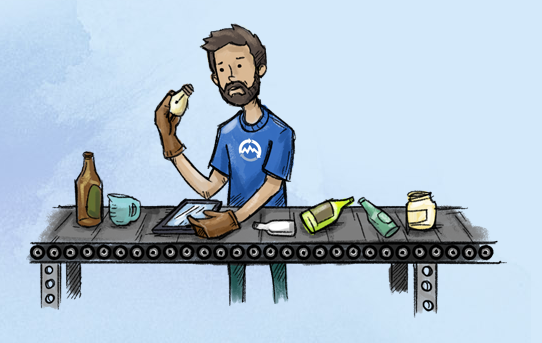Step 1: You Recycle Your Glass
Deposit your glass in an area glass drop-off bin or your curbside glass bin.
Step 2: Collection & Delivery
Step 4: Glass Breaking
24 hammers, each the size of a forearm, spin quickly around an axle, breaking the glass into crude particles for future optical sorting. A slight water mist is applied when necessary to control airborne particulates.
Step 5: Trommel
Broken glass particles are passed through a revolving screen and sorted into 3/8” and 3/4” sizes. Fans propel the paper labels detached during breaking through the trommel and into a paper recycling bin.
Items that don’t shatter and cannot fit through the screens (corks, caps, lids, errant labels) are collected and recycled.
Step 6: Fluidized Bed Drier
A smooth ribbon of glass particles enters the drier in a 4” bed. Vibratory action moves the particles through the drier.
Air is heated to 190 degrees F, using natural gas and forced through the bed of the drier. Think air hockey. Sugars and bacteria are burned and label glue is loosened. Residue floats to the top and is sucked away via our vacuum system.
Step 7: Primary Rotary Screen
Dried and cleaned glass is screened to cull out specific sizes. Screens are quickly changed to produce different size grades for different customers. For example, fiberglass manufacturing requires all particles to be 12 mesh or smaller.
Step 8: Pulverizer
Glass particles that are too big to fit through the primary screen are sent through the pulverizer. Similar to the breaker, the pulverizer uses 36 hammers inside a small enclosure to aggressively reduce particles size. All particles recirculate until they finally pass through the primary screen.
Step 9: Secondary Rotary Screen Size Classifier
Particles that are small enough to pass through the primary screen are then processed through the secondary screen. Particles are separated into four size grades:
• 12 mesh to 20 mesh
• 20 mesh to 40 mesh
• 40 mesh to 70 mesh
• 70 mesh and smaller
Each size grade is used for different end markets.
The Final Product
Glass cullet is classified in sizes that can range from pebbles to sand and even powder.
Post time: Jul-19-2022














